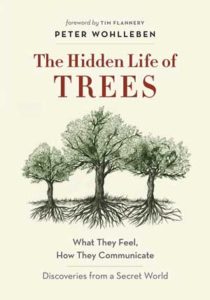The Hidden Life of Trees: What They Feel, How They Communicate—Discoveries from a Secret World
Reviewed by Ruah Swennerfelt
September 1, 2017
 By Peter Wohlleben. Greystone Books, 2016. 251 pages. $24.95/hardcover; $24.99/eBook.
By Peter Wohlleben. Greystone Books, 2016. 251 pages. $24.95/hardcover; $24.99/eBook.
Buy from QuakerBooks
“After you’ve read Wohlleben’s book, a walk in the woods will never be the same.” That’s what it says on the cover of The Hidden Life of Trees, and it is so very true. I look at the woods that surround our home in Vermont and I recognize the intelligence that resides in the trees that are so bountiful. Did you know that during the winter pine trees insert anti-freeze into their needles so that the freezing temperatures don’t destroy those needles? Did you know that in some tree species the mother tree actually looks out for her offspring by nurturing and protecting them?
Wohlleben doesn’t anthropomorphize the lives of trees. Their intelligence is very different from ours. But they do have a form of intelligence. Each species has its own way of propagating and surviving hard times. Some even move to new locations. Wohlleben writes:
Trees can’t walk. Everyone knows that. Be that as it may, they need to hit the road somehow. But how can they do this without feet? The answer lies in the transition to the next generation. . . . Some species are in a big hurry. They equip their offspring with fine hairs so that they can drift off on the next wind, light as a feather. . . . [Some] enter into an alliance with the animal world. Mice, squirrels, and jays love oily, starchy seeds. They tuck them into the forest floor as winter provisions.
I was fascinated by the myriad of ways that trees have adapted to changing climate, human development, storms, and other big interferences with their habitat. But sometimes they succumb to those interferences. And sometimes, even with humans’ best intentions, they have to struggle to survive. It’s wonderful to have trees in our cities. But according to Wohlleben, they don’t reach their full potential since their roots are often struggling to grow in the compacted soil that surrounds them. Sometimes they don’t have the trees of the same species that they depend on in the forest. Therefore they’re “lonely,” not receiving the nurture and protections of their cousins like they would get in their natural environment.
Wohlleben spent 20 years working for the forestry commission in Germany. He now runs an environmentally friendly woodland, where he works for the return of primeval forest. His extraordinary knowledge of, love of, and respect for trees is evident in every page. I know that what I’ve learned from him will help me as I consider the care of the trees in our woods. I already felt a new camaraderie as I inspected our fruit trees today. I know I will feel a kinship with trees I never felt before.



Comments on Friendsjournal.org may be used in the Forum of the print magazine and may be edited for length and clarity.